Norwich City have become quite a ‘yo-yo’ club in recent years, with the Canaries having achieved promotion to the Premier League and then relegation back to the Championship the very next season twice in the last six seasons. They finished at the bottom of the table last season, going down with a whimper, and not many would have backed them to make an immediate return to the top table. However, the club management stuck by Daniel Farke and his methods, as well as the vast majority of the squad that had got them there in the first place, and the results are there for all to see now.
Norwich City have clinched promotion to the Premier League at the first time of asking, and with six games to go at the time of writing, they are eight points clear of Watford in second place, and therefore in the driver’s seat to win the Championship this season. This has been a remarkable achievement by the Canaries, and it is quite the statement from Farke and the Norwich squad after they were written off following last season’s disastrous Premier League outing. This tactical analysis piece will look at Norwich’s system of play and tactics this season, in a bid to understand just how they have been so impressive in the second tier, and whether they can translate this in some manner to the Premier League next season
In possession
A good way to understand Norwich’s style of play under Farke this season is to look at a few metrics in comparison with the rest of the Championship.
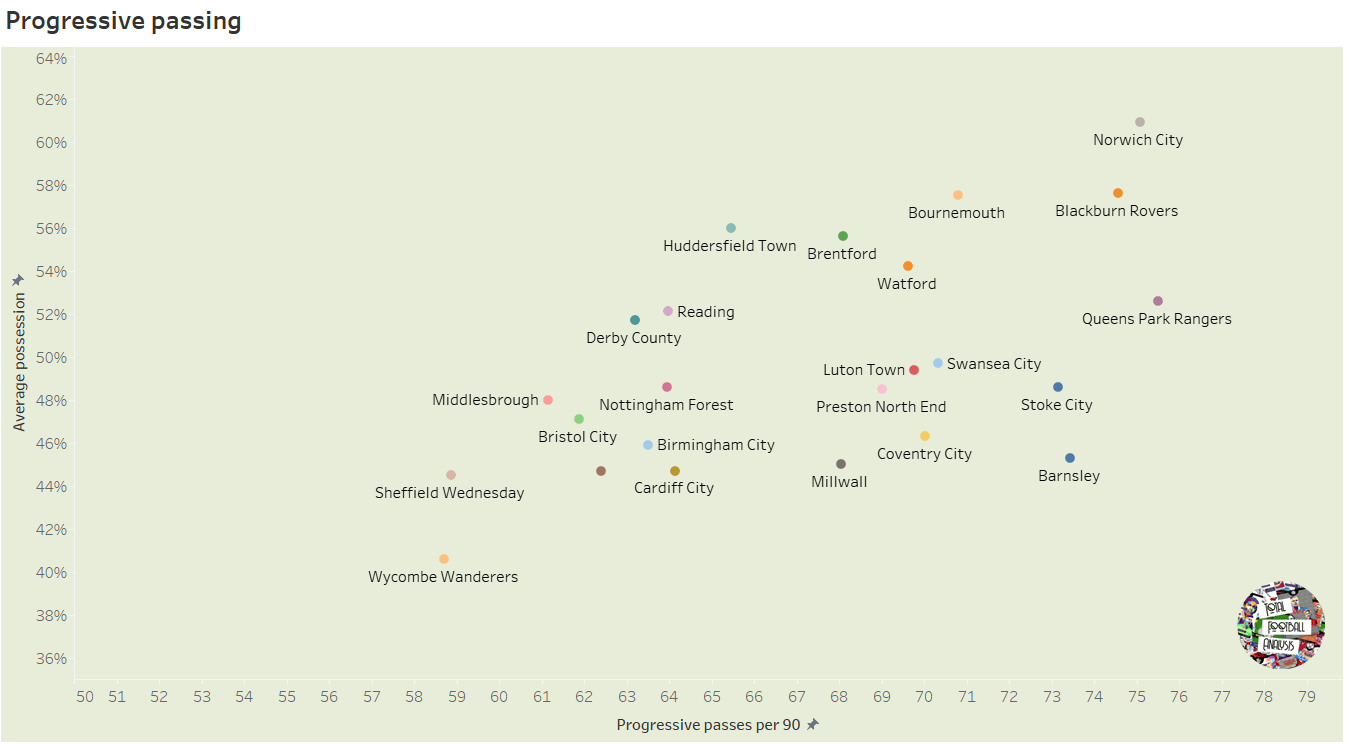
Our first scatter plot looks at average possession and progressive passes per 90 for the 24 teams in the Championship this season, as this is a good way to understand which teams keep the ball more, but also try and do something with it as much as possible. Norwich have averaged the highest possession in the league this season (60.9%), while they have attempted the second-highest progressive passes per 90 (75.01), only marginally behind Queens Park Rangers. This shows that while they try and keep the ball, the emphasis is firmly on penetration, with Farke’s side looking to get the ball up the pitch and into advanced areas as frequently as possible.
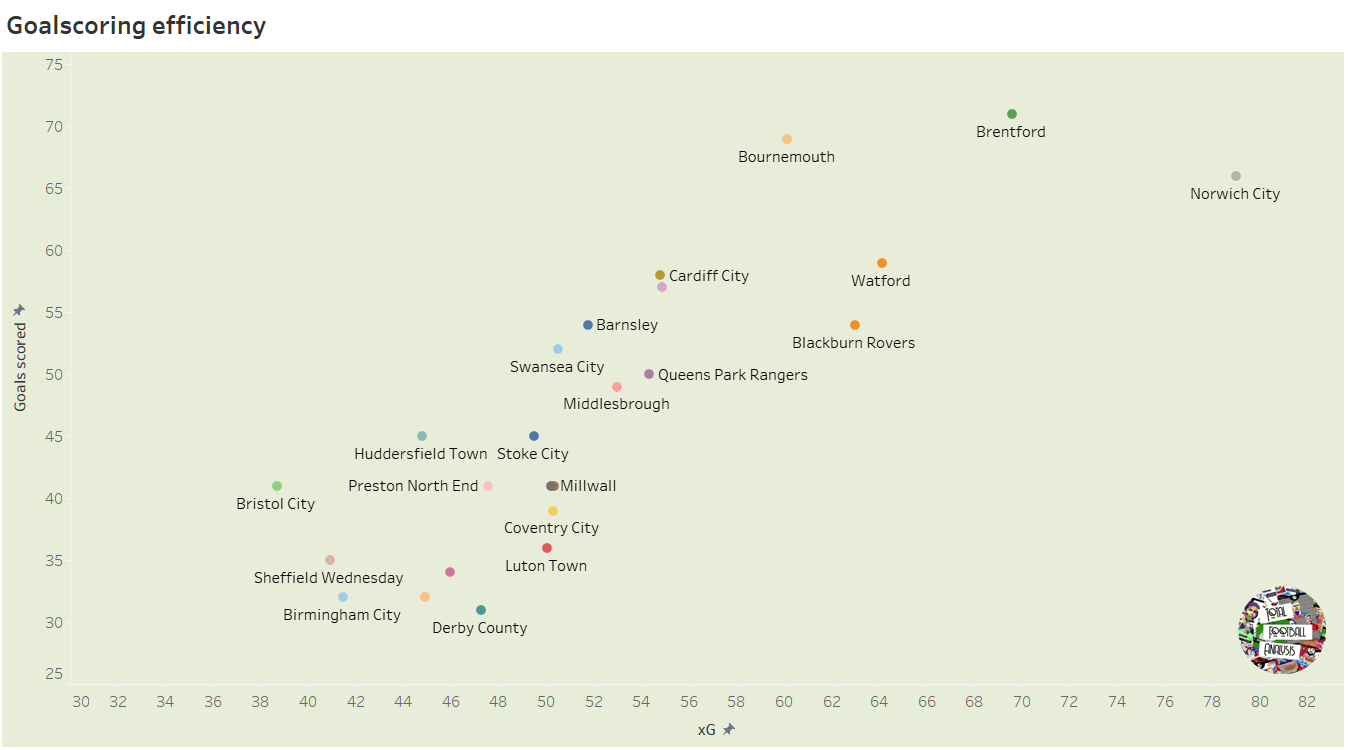
Keeping the ball is all well and good, but you need to be able to do something with it, namely, score goals. This chart looks at the teams’ actual goals scored against their expected goals (xG) totals thus far this season, as a measure of their efficiency in front of goal. Norwich are leading the league in terms of xG (78.99), but have actually underperformed in terms of goals scored, netting 66, which is the third-highest in the league. This could be a potential issue in the Premier League, and one that Farke will need to consider ahead of the new season. Creating chances and not taking them will be heavily punished in the Premier League, and as Brighton are showing this season, becoming the darling of the analytics community for creating high-quality chances is not worth it if you do not take them.
Nevertheless, the Canaries have certainly been impressive this season, especially in possession, and we will now look at some of their key principles and tactics when they have the ball through in-game examples.
Daniel Farke has primarily set his side up in a 4-2-3-1 shape this season, which has allowed him to get his most creative players, such as Todd Cantwell, Kieran Dowell and Emiliano Buendia into the side.
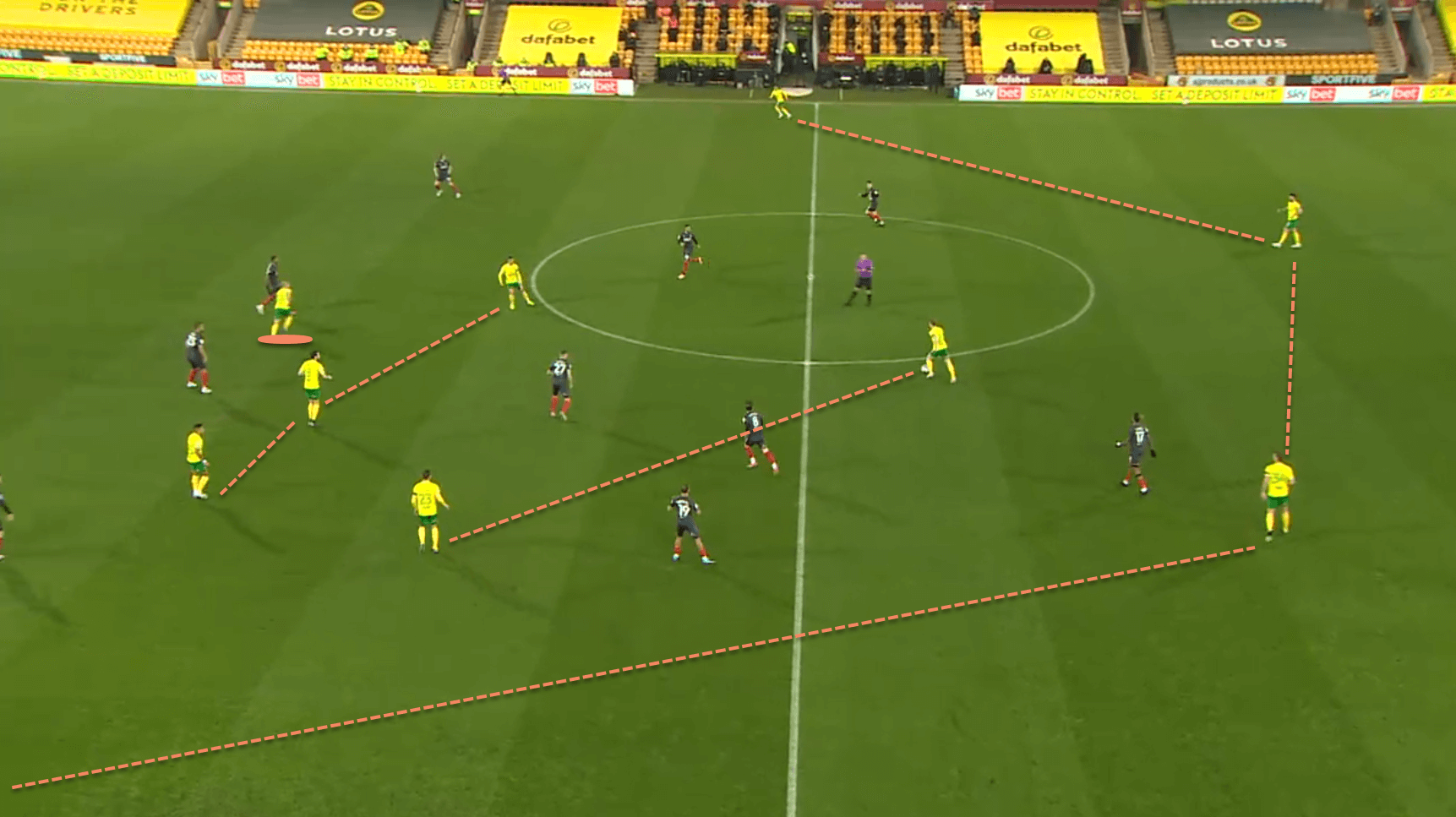
This image, from the game against Brentford, is a good example of their usual shape. Note how the left-back is out of shot – under Farke, the full-backs hold their width on both flanks to stretch the play and create space centrally for their trio of playmakers behind Teemu Pukki. We can also see how narrow that attacking band of three players is, and how all three of them are in between Brentford’s midfield and defensive lines. These are key principles of Norwich’s attacking strategy – the full-backs provide width, which allows the wide players to come infield and play narrow. This keeps them in close proximity to each other and Pukki, which enables quick combinations and passing moves, while it also allows them to rotate and drift across the pitch. These three players are also usually tasked with getting between the lines to receive the ball as frequently as possible, with Oliver Skipp and Kenny McLean in midfield attempting to find them in those areas to allow the Canaries to attack quickly and efficiently.
The Canaries usually attempt to build-up in a 3-2-5 shape, with one of the full-backs staying back while the other moves up the pitch to join the attacking band. Alternatively, if both full-backs stay high and wide, one of the midfielders will drop into the defensive line, as we will see next.
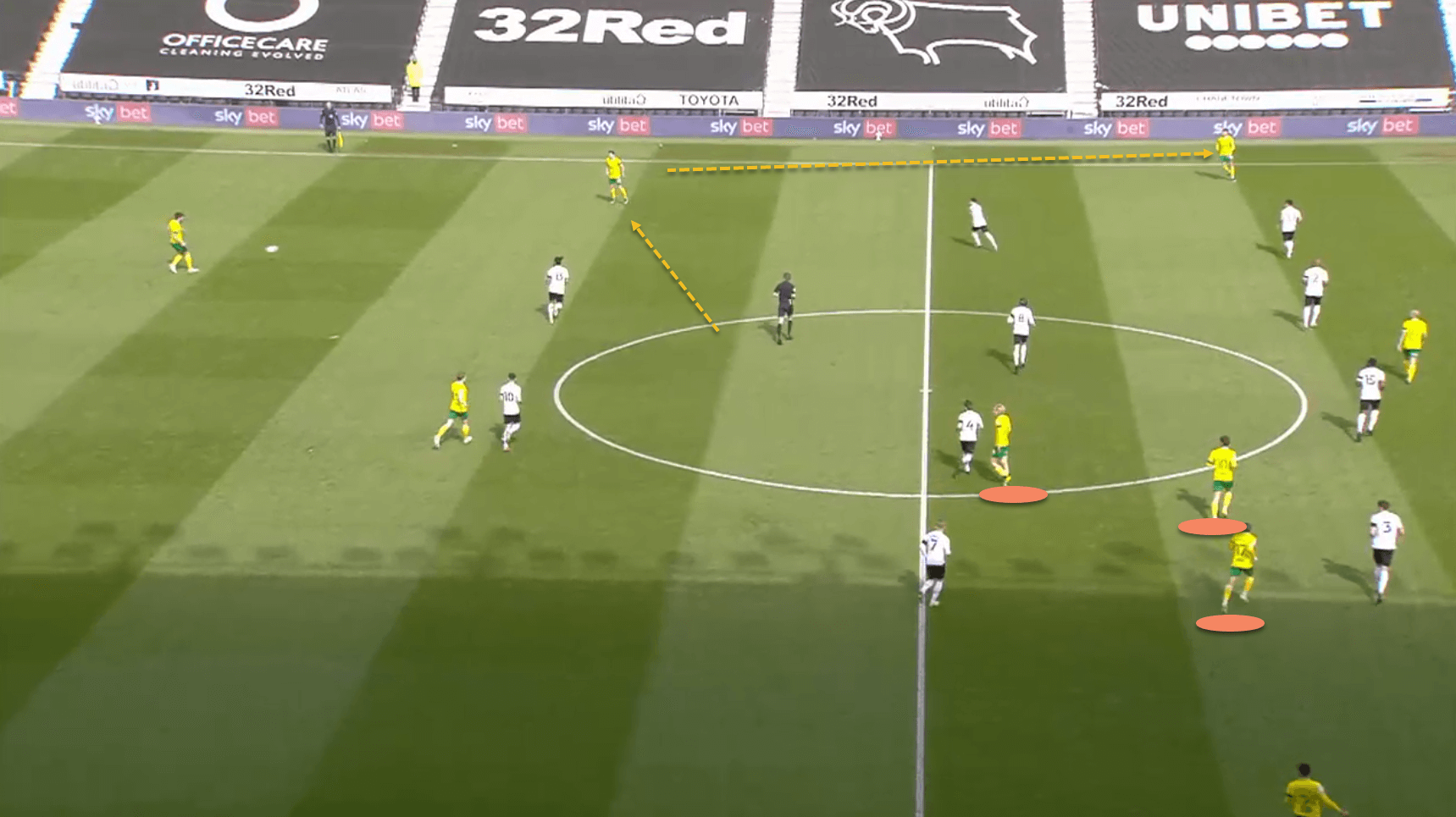
Norwich employ a few strategies to ensure that their full-backs are able to stay high and wide, and one of these is to have the left-footed Kenny McLean drop into a left-back position, as we can see in this image. This frees up the left-back, usually Dimitris Giannoulis, to move up the pitch. Note how wide Max Aarons is at the bottom of this image as well – this is another example of Norwich’s full-backs keeping the width to allow the three attacking playmakers (highlighted) to roam and find space centrally.
Of course, it is not just McLean who does this – Oliver Skipp goes out to the full-back positions on occasion as well, while we have also seen Todd Cantwell drop in at right-back in a similar manner. The basic principle remains the same – to allow the full-backs to get up the pitch and maintain width.
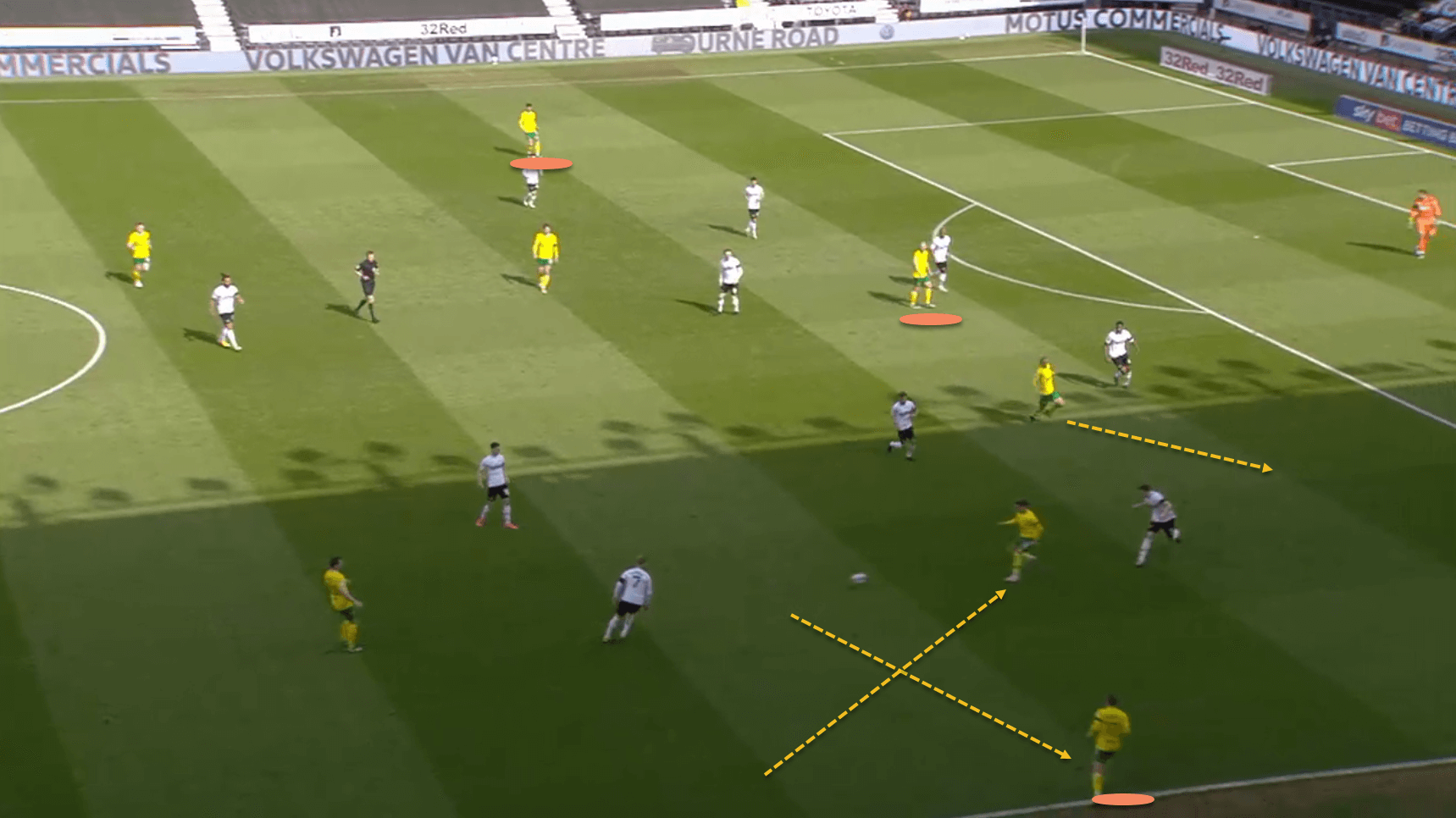
We mentioned how Norwich also employ rotations during established possession and attacking play phases as well, and this is a good example of this trait. Here, Buendia, the right-sided winger, is the one staying on the touchline to maintain width, with Aarons having gone into a more central position instead. Todd Cantwell, who nominally started on the left, is attempting to make a run off the Derby centre-back into the right half-space, with Pukki occupying the other centre-back. Again, note the wide positioning of the left-back on the opposite side of the pitch as well. These rotations and positional interchanges allow Norwich to be able to play quick passing combinations between the lines, and also help to create doubt and confusion in terms of the opposition’s defensive and marking schemes.
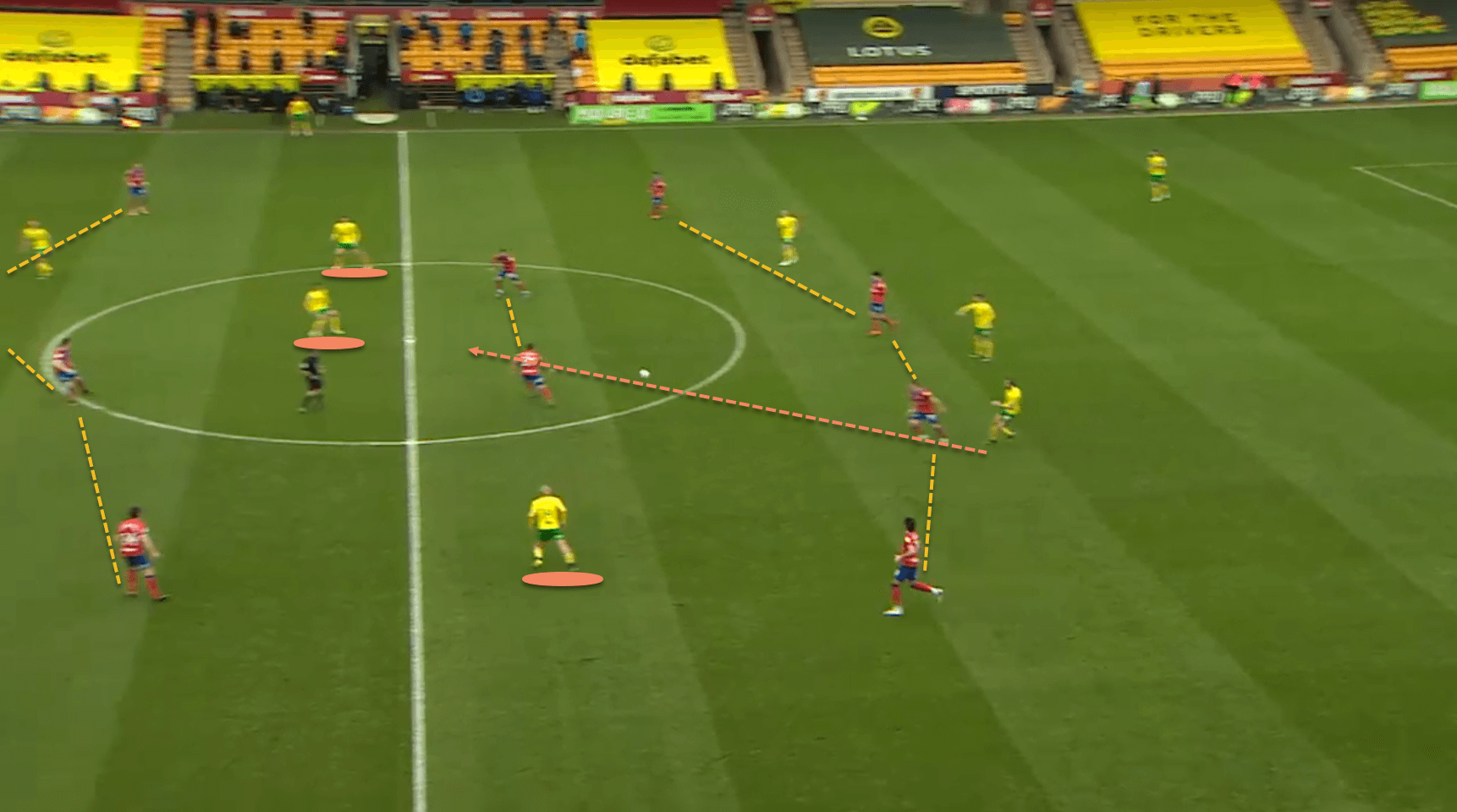
The Canaries are almost constantly attempting to find space between the lines through their attacking trio, and their narrow positioning helps them to pick up these positions in all three phases of possession. In this example against Blackburn, Ben Gibson is able to play a pass into Kieran Dowell’s feet with the former Everton man situated between the lines and Buendia in close proximity, while Cantwell is also in space, albeit in a slightly wider position to the right of Blackburn’s midfield duo. Norwich prioritise this to a large extent when they have the ball, and it is one of the reasons why Buendia has been so prolific this season, as he is constantly able to get on the ball in central areas, rather than being out on the flank.
Out of possession
While Norwich have been extremely impressive in possession this season, their defensive work has perhaps not been at the same level, and this could be a problem that needs solving before next season’s Premier League campaign.
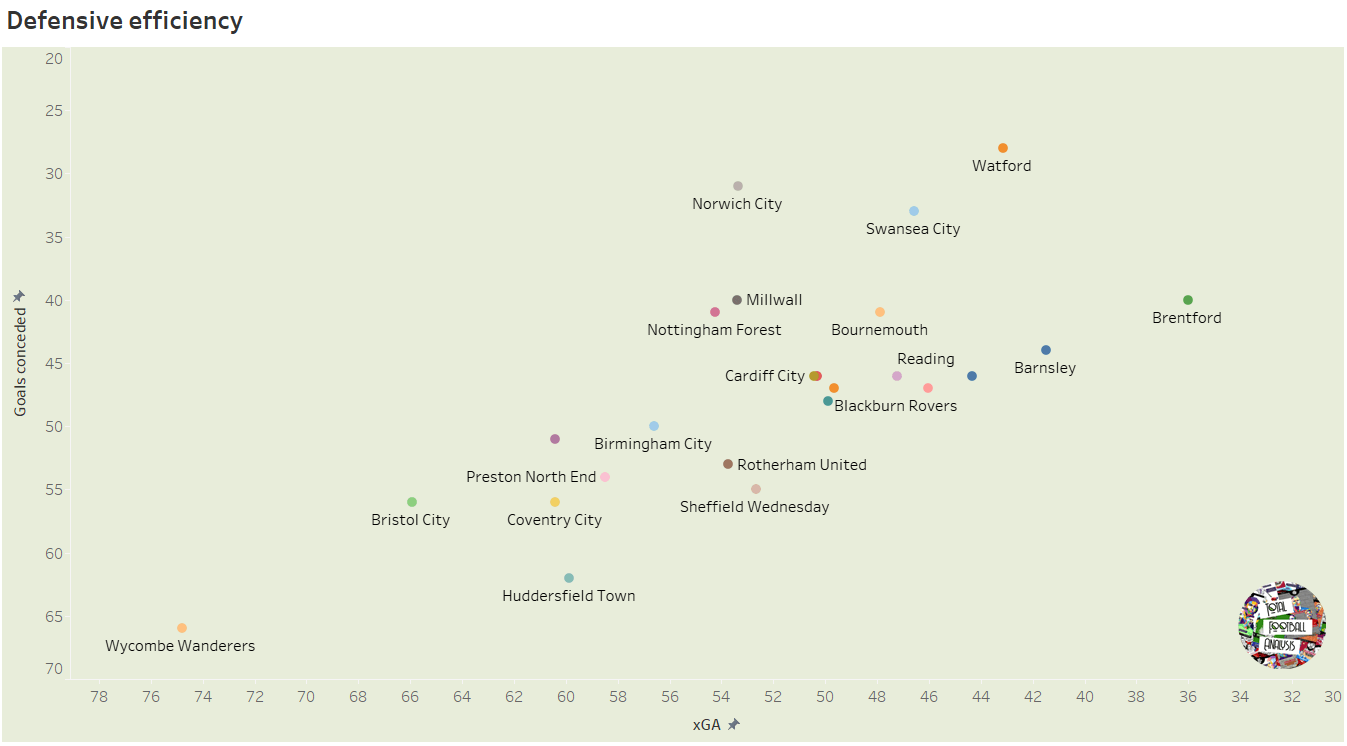
This is borne out by our next chart, which looks at expected goals against (xGA) and actual goals conceded for the 24 Championship sides. While the Canaries have conceded just 31 goals this season, which is the second-lowest in the league, their xGA is far worse, at 53.36. In fact, their xGA total is the 11th highest in the Championship, which perhaps makes a case for them having been quite lucky defensively. Thus, Norwich have underperformed both their xG and xGA totals this season, and therefore, despite looking likely to win the Championship, these are both areas of concern for Farke and his team ahead of promotion.
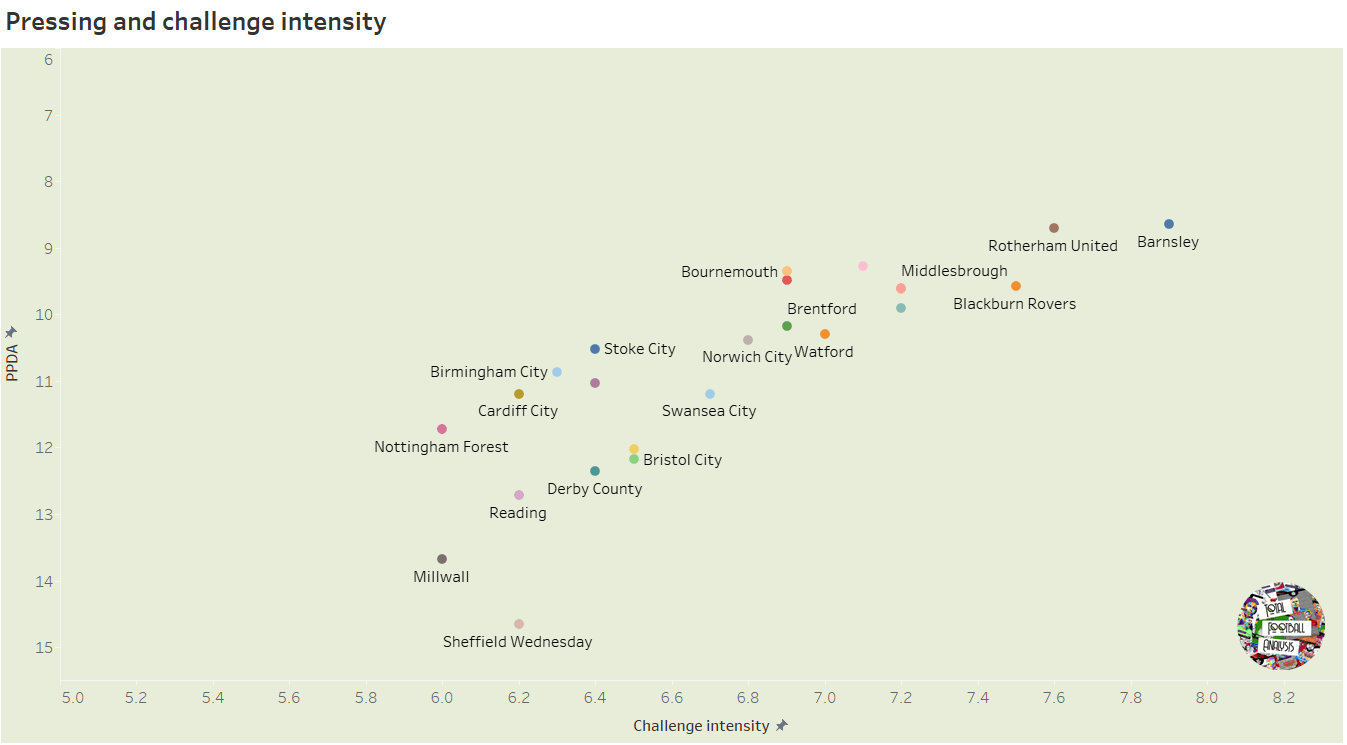
It is also intriguing to look at PPDA and challenge intensity, as taken from Wyscout, as this gives us an indication of the team’s defensive style. The Y-axis has been reversed here, to account for the fact that a lower PPDA means more intense pressing. Norwich are firmly in the middle of the pack for both metrics – their PPDA of 10.38 is only the 12th lowest in the league, while their challenge intensity (which is the number of defensive actions a team makes per minute of opposition possession) is 6.8, which is again only the 12th best in the Championship. Interestingly, these numbers are still an improvement from their performance in the Premier League last season, especially in terms of PPDA, where Norwich had the sixth-highest tally in the league with 13.44. Nevertheless, these metrics paint a picture of a side that does not press too aggressively, and can look to sit back on occasion as well.
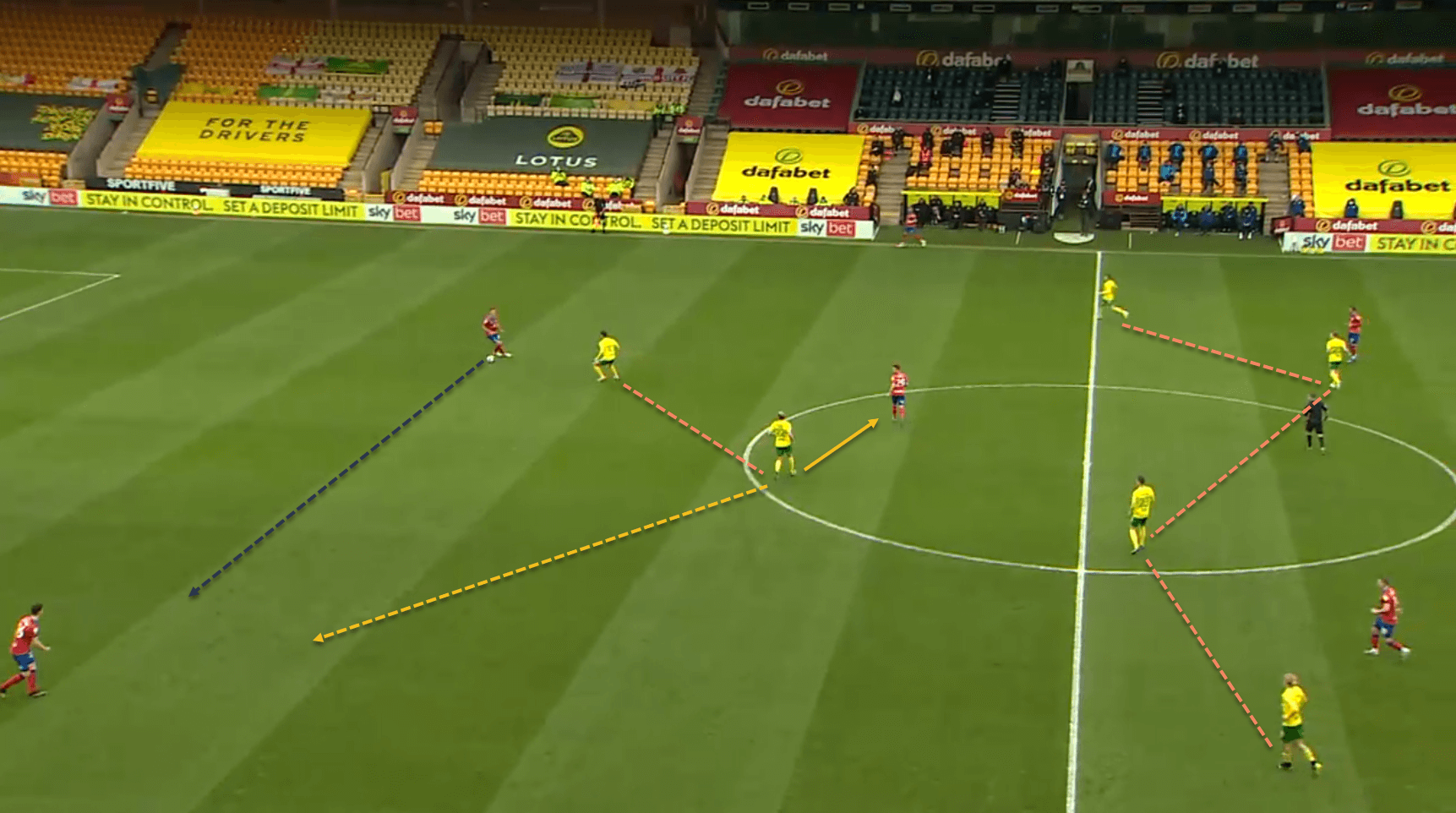
Norwich usually move into a 4-4-2 shape without the ball, with the central number 10 supporting Pukki up front. These two players generally only look to press the opposition centre-back on their side of the pitch when he is on the ball, with their partner then dropping slightly deeper to mark the deepest opposition midfielder and cut off easy passes into him, as we can see in this image.
Norwich are quite happy to let the ball progress into wide areas, which is where they begin to press with a little more intensity to regain the ball. This is a strategy used by many teams, as they use the touchline as a natural barrier to reduce the size of the playing area and therefore squeeze the space for the opposition to play in.
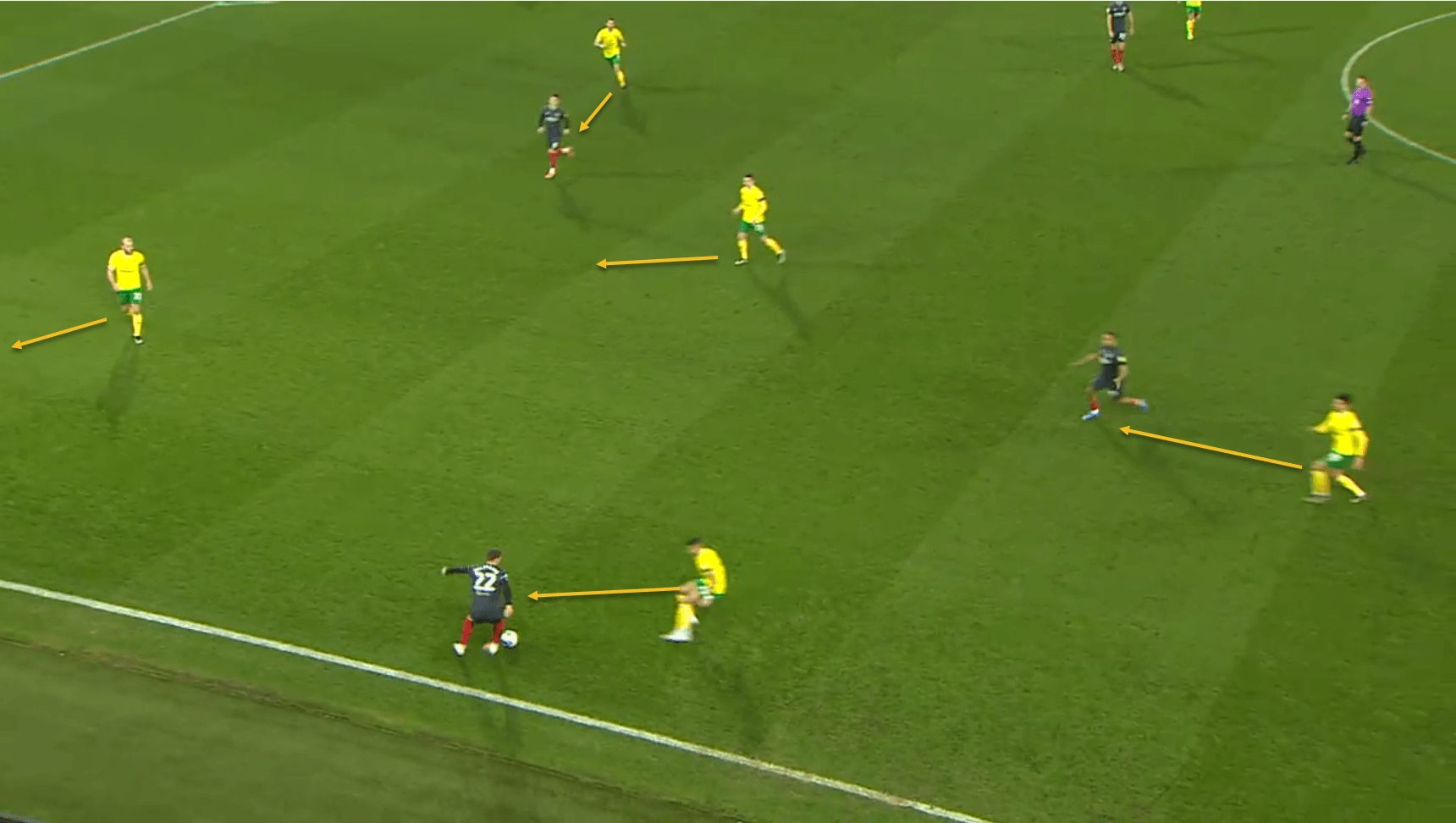
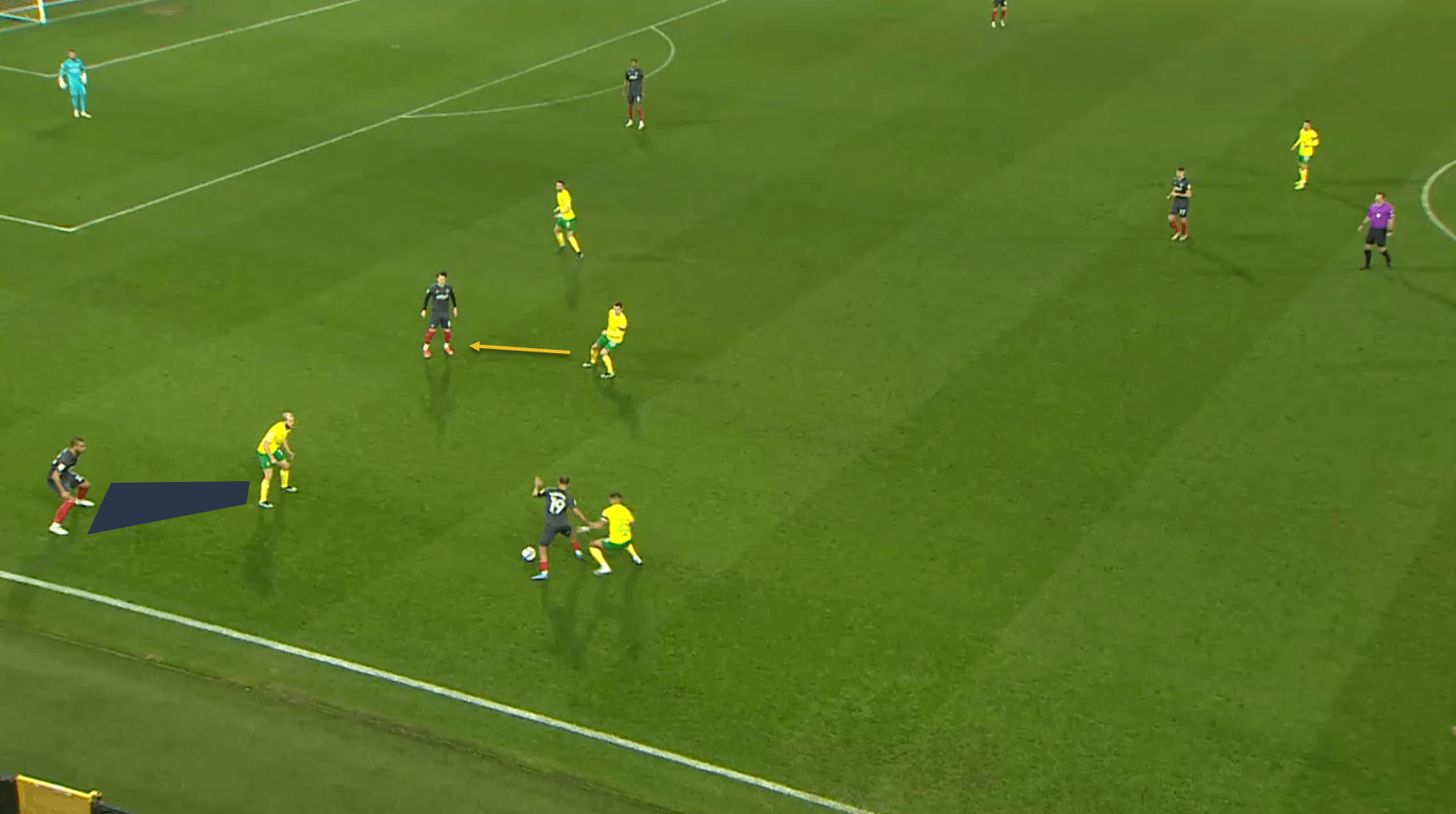
These two images are a good example of this tactic. With the Brentford full-back isolated on the touchline, Norwich press intensely – Onel Hernandez engages the full-back, while Giannoulis tracks the winger. Pukki is cutting off the pass back to his teammate, while two Norwich players are also dropping to cover the pass infield to the centre-back.
Mbuemo, the Brentford winger, does pick up possession, but he is still being heavily pressed by Giannoulis, while Pukki uses his body to block the pas to Winston Reid, and Mario Vrancic is on hand to pounce if the ball is played infield.
During sustained spells of opposition possession, the team does look to drop and stay compact between the lines, with the wingers falling back to track opposition full-backs, and the midfield pivot protecting the half-spaces, as we can see in the next image.
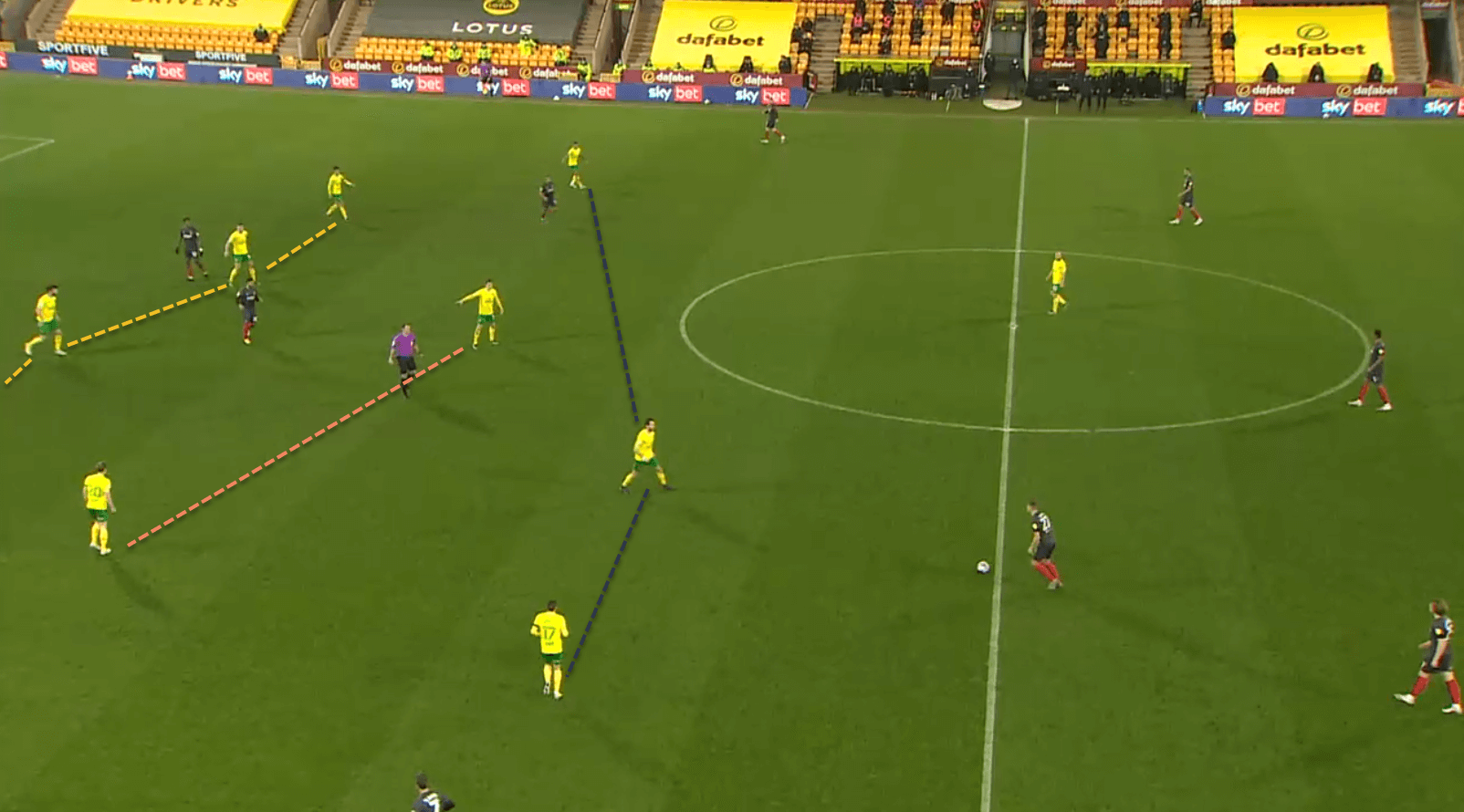
Norwich do have a tendency to leave space between the lines, especially if the attacking trio is pressing wide and the ball gets played behind them, since the midfield pivot usually stays relatively deep. Their defensive line does push up to try and account for this issue, but this is something that will have to be improved in the Premier League, where better teams will punish them for leaving space in this manner in dangerous areas.
Conclusion
Norwich City have been extremely impressive in bouncing back immediately to the Premier League with the same core of the squad that went down with such a whimper the previous season, and Daniel Farke and his coaching staff deserve a lot of credit for this. We can expect them to play in a similar manner in the Premier League as they did in the Championship this season, but they will definitely need to improve their efficiency in both boxes if this is not to be yet another downward swing of the yo-yo.

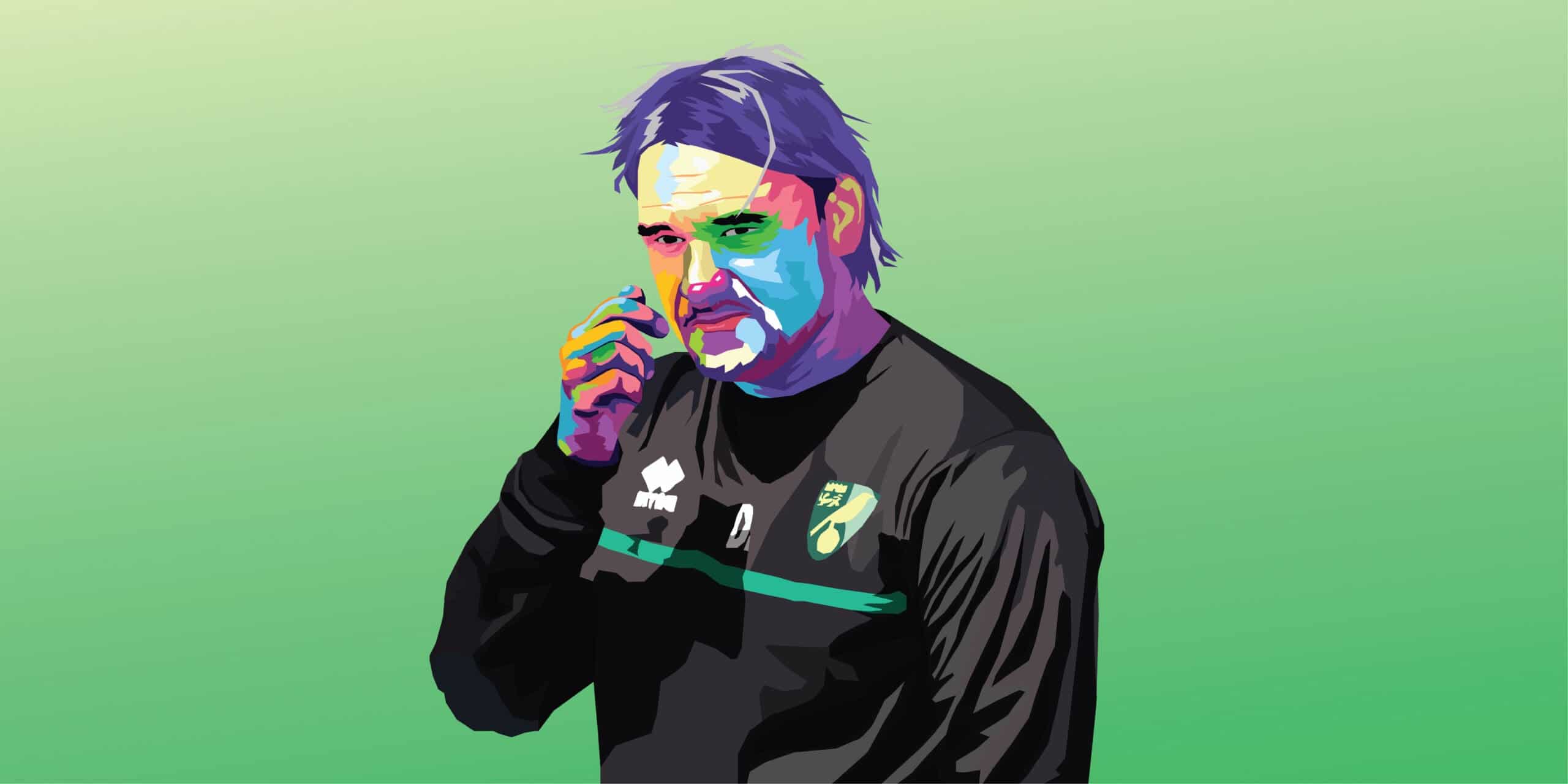


Comments